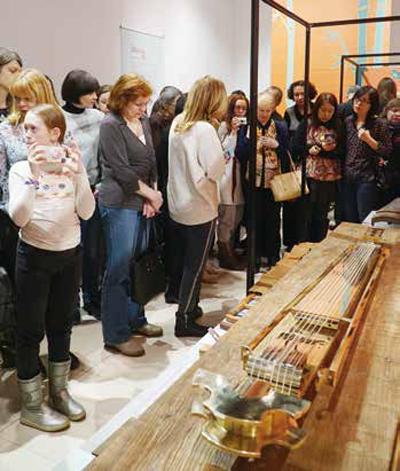在莫斯科展示中国生活之美
2019-04-19蔡琴
蔡琴
莫斯科当地时间2019年2月27日晚上6点30分,俄罗斯莫斯科中国文化中心张灯结彩、高朋满座,由浙江省文化和旅游厅、莫斯科中国文化中心共同主办,浙江省博物馆承办的“东方生活美学展”在此拉开帷幕,200多位莫斯科朋友参加了开幕式并参观展览。
此次展览是中俄建交70周年纪念的启动项目、2019年莫斯科“欢乐春节”活動之一,亦是2019·俄罗斯浙江文化旅游年开幕大展。展览持续至3月18日,受到了俄罗斯观众的广泛好评,展厅里挤满了前来观展的人群。俄罗斯金砖电视台、大亚洲电视台,中国的新华社、人民日报、人民网、国际台、凤凰卫视等多家媒体到场,对展览进行了深度报道。
俄罗斯东方博物馆负责人谢多夫·弗谢沃洛多维奇表示,东方生活美学展为俄罗斯人了解东方生活和古典与现代一脉传承的中国生活之美打开了一扇窗。

一个源于中国传统文化的临时性展览,为何能够得到文化差异甚大的俄罗斯观众的喜爱呢?
琴棋书画诗酒花茶香
2018年浙江省博物馆推出了原创性海外巡展项目“江南生活美学展”,“东方生活美学展”是“江南生活美学展”的升级版,呈现出原汁原味的东方生活之美。
中国传统文化底蕴深厚,源远流长,10世纪以后,社会繁荣,商贸昌盛,从士家大族至市井百姓,不懈于追求美感的体验与诗化的生活。从建筑、家具、生活用品、衣饰、饮食等日常生活中提炼出高雅的品位,更展现在文学、书画等作品中,这种清丽风雅的审美品位,创造出丰厚的物质与非物质文化,亦成为东方古典美学的代表,直至今日。
于是,代表中国传统生活美学中的精致与典雅,又以艺术的形式回归当下生活。满足现代社会高速发展中人对和谐生活和沟通交流渴求的“琴、棋、书、画、诗、酒、花、茶、香”便成为不二选择。
“琴棋书画诗酒花茶香”在我国古时被称为“九雅”,有些是技能,有些是品位,常用来表示个人的文化素养,在博物馆的收藏中,它是一件件实物,也是一个个“东方生活美学”符号。
展览把“琴棋书画诗酒花茶香”九方面内容整合成四个单元,第一单元“一枝红艳露凝香”(花和香),第二单元“此曲只应天上有”(琴),第三单元“人间有味是清欢”(茶和酒),第四单元“忘忧清乐在枰棋”(棋),用诗意和书画、故事贯穿全场。
内容上,在“琴”的板块里增加了以昆曲、京剧为代表的中国戏剧;形式上,运用现代设计理念构筑展览叙事性空间,色调上采用珊瑚红和松石绿的搭配,利用梅兰竹菊四元素穿插结合,与俄罗斯风格的原建筑形成对比,把空间塑造为一种差异的综合体,让古琴、茶道、品酒、花艺、焚香、棋艺等从一个个小空间出发,扩充到整个氛围。并且,通过气氛、灯光的烘托,营造空间上“曲径通幽”的东方文化感,将静态的展览转化成“剧场式”的动态。
让展品讲出自己的故事
博物馆收藏的文物,作为一个个载体,很多是古人在诗情画意中善用其心,以静境为追求、修身齐家治国平天下为襟怀,以和谐圆满为哲学、大爱为彼岸的真实写照。所以这次展出在展品的选择上,从本体细节和信息、诗意、社会变迁和故事入手,古典和当代艺术相互激发、互相启迪,形成视觉和审美上的对话。在这种复杂的对话中,建立起关于古今、中西之间关系的新构想。这种关系不是单方面的,更是一系列多层次的深入交流,是一种以共享的形式存在的共同语言。
比如浙江杭州万事利丝绸文化博物馆提供的织锦挂画《平湖秋月》,是由国家级非物质文化遗产丝织技艺传承人陈家泠画作为原型创作的,丝绸的细腻精致将画作的简约空灵体现得淋漓尽致,是一幅高度提炼后的现代艺术佳作。

同样由浙江杭州万事利丝绸文化博物馆提供的绛红地寿字八吉祥纹织金锦,原件为故宫博物馆藏清光绪帝大婚时杭州织造进贡的一块匹料,属于云锦中的妆花织金缎,是“织金”和“妆花”两种工艺相结合的产物。这块复制品完全按照原件工艺、色彩制作而成,无论是纹饰色彩还是织造技艺,都再现了传统丝织工艺的高超水平。
苏州张斌戏剧服饰工作室提供的梅派女蟒、镶边白蟒、湖绿梅花女褶子是三套以传统手工刺绣制作的戏剧服饰,原汁原味,精美典雅。
浙江省博物馆藏元代赵孟頫《吴兴赋》,正行相间,时参草书,点画雅致,体势舒展,章法整饬,神气一贯,展览现场展示了其高精度复制品。
“东方生活美学展”通过引人入胜的视角来讲述故事,观众被吸引,由此产生共鸣。古代高逸之人,或携琴进山,或棋枰手诶,小童烹茶,流水潺潺、古松奇石间,赏花、焚香、弹琴对弈,彼时彼刻,山水即为知音。观众在展厅移步观看古人的这一切,此时此刻,乾坤便在心中。
“讲故事”是一个展览叙事能力的体现。故事能让参观者集中注意力,也能让人们站在某一特定的立场,去感受东方传统文化儒雅生活魅力,提升心灵体验和精神意趣,把展览的美学主题变成了生活主题。
如果展览擅长讲故事,有能力讲故事,将这些故事带到幕前,或许可以重新塑造人们对于一些器物和历史事件的看法,而人们看待历史和当今社会的角度也可能发生改变,甚至能够改变人心。
“东方生活美学展”在展品的选择上,特别关照当代部分作品。当代艺术家和手工艺工匠带着好奇心和探索欲,从古典出发,通过记录“东方生活美学”的时代变化的载体,表达内心情感。这些展品代表着变化,一种是时代风格的变化,一种是生活方式的差异,但不是复制而是重塑,让古今以一种对自然理解的共通性融合为一体,为每个观众提供一个远离工作繁忙、生活压力的平静港湾。

比如由著名雕塑家、杭州市雕塑院院長林岗制作的“九霄云佩”琴,具有强烈的后工业时代痕迹。他把使用过的、废弃的工业机械零件,采用焊接、铆合、螺丝组装等后现代的挪用与重组,构筑了独特的艺术世界。
此外,还有浙江音乐学院徐君跃老师提供的整套古琴制作工具和配件,观众可以直观了解古琴制作的工艺和每个配件代表的象征意义。
对生活之美的共同追寻
“东方生活美学展”的互动体验吸引了不同年龄、族群的人们。
博物馆“参与度”含义广泛,不仅包括观众人数增长,还意味着博物馆给观众提供沉浸式的、有趣的学习体验。书法秀、古琴弹奏体验、场景拍摄、茶文化讲座等一系列配套活动,为观众提供尝试体验的新方法。许多莫斯科朋友被展览呈现的东方之美打动,主动参与展览互动,抚琴、挥毫、作画,还进入艺术展示场景里留影。
博物馆与观众的关系是相互和多边的,观众既是展览信息的接受者,也是展览信息的制造者。很多观众在俄罗斯的社交媒体上分享了参展的体验和收获,这又促进了公众的参与,为彼此带来了生机与活力,并催化新的思维方式、新的文化和新的精神。
就像浙江省博物馆馆长陈浩说的那样,“无论西方还是东方,人们都有着对生活之美的共同追寻。文化交流是双向的,我们愿意为俄罗斯观众搭建一座了解中国的桥梁,同俄罗斯博物馆共同合作,让俄罗斯文化通过我们的平台进行展示。”
中国驻俄罗斯大使馆文化参赞、莫斯科中国文化中心主任龚佳佳的一番话,表达了她对这个展览的评价和解读。她说:
众所周知,美学是文化的重要组成部分,它渗透在社会生活的方方面面,影响人的生活方式和行为方式。在古代中国,有一批人,特别是贵族阶层和知识阶层,他们有足够的财富和足够的时间(有钱有闲),打造出一种更加精致讲究的生活,这种风尚慢慢地扩展到普通市民阶层,在建筑、服装、家具、陈设、食物以及日常生活的方方面面都追求情调,讲究风雅。这一风尚也逐渐出现在文学、书法、绘画以及艺术品中。
感谢我们中国古代的士大夫们,是他们构建了系统的 美学原则,给我们留下了宝贵的文化遗产,教会我们如何在平凡的生活中发现美,在琐碎的事务中发现闪光点,培养人们对于优雅的敏感之心,让生活变得诗意纵横。
这里所展出的物品,向观众们讲述古代中国的知识阶层,他们做些什么,如何经营日常生活,如何正确地喝茶、正确地着装,正确地焚香,什么样的花要配什么样的瓶子等等,这些东西乍看起来不具有现实的紧迫性,但却让人们学会如何理解和欣赏自然及生活中的美好。
我想引用一下中国宋朝著名诗人程颢的诗句:闲来无事不从容,睡觉东窗日已红。万物静观皆自得,四时佳兴与人同。让我们保持内心的平静与和谐,从容地发现和享受我们日常生活中的每一刻。
(本文图片由王宣艳摄)
Oriental Life Aesthetics Exhibited in Moscow
By Cai Qin
“Oriental Life Aesthetics”, an exhibition undertaken by Zhejiang Museum and sponsored jointly by Zhejiang Administration of Culture and Tourism and the China Cultural Center in Moscow, opened its door to the public at China Cultural Center in Moscow, Russia on the evening of February 27, 2019. This is one of the events to mark the 70th anniversary of the founding of diplomatic relations between China and Russia as well as in celebration of the traditional Chinese New Year 2019. This exhibition marked the beginning of Russia-Zhejiang Tourism Year. The exhibition lasted till March 18 and was covered by mainstream media in both Russia and China.
Meant for international audiences, this exhibition was an upgrade of a 2018 exhibition featuring Jiangnan life aesthetics designed to attract the attention of the public in China. Chinese culture originated in prehistoric times and evolved through centuries. It was in the 10th century that our culture flourished to a historical new high, producing a refined aesthetics as seen almost all aspects of social life such as art, calligraphy, poetry as well as in architecture, furniture, household utensils, garments, food and beverage. In a sense, , , calligraphy, painting, poetry, wine, flower, tea, and perfume can represent the cultural essences of human relations and individual qualities.
The exhibition in Moscow condensed the nine into four exhibition sections. The first part concentrated on flowers and perfumes. The second section highlighted Guqin, a plucked seven-string Chinese musical instrument with a history of about 5,000 years. This section also presented Kunqu Opera and Peking Opera, two Chinese opera genres that highlight poetry, arias and dance. The third was about tea and wine; the last presented Weiqi, a board game that is as old as Guqin.
The four sections were well arranged in design, decoration, and color to give full play to the essence of the nine aspects of Chinese life aesthetics.
Zhejiang Museum played a central role in showing exhibits from its collection. A replica of , a masterpiece of calligraphy by Zhao Mengfu (1254-1322) of the Yuan Dynasty, was exhibited. The original is now in the collection of Zhejiang Museum.
And minor museums and other cultural institutions also made remarkable contributions to the exhibition. A brocade tapestry featuring “Autumnal Moon on Calm Lake”, a poetical portrayal of a famous scene on the West Lake in Hangzhou, was from the collection of Wensli Cultural Museum in Hangzhou. Wensli is Chinas top silk maker. Based on the namesake painting by Chen Jialing, the tapestry was made by a designated master of national intangible cultural heritage. Also on display from Wensli Cultural Museum was a modern reproduction of a brocade piece originally designed and made for the wedding ceremony of Emperor Guangxu (1871-1908) of the Qing Dynasty. The original was made in Hangzhou under supervision of a government office in charge of textile manufacturing.
Zhang Bin Theater Costume Studio based in Suzhou contributed three costume pieces, all embroidered exquisitely and luxuriously, reflecting how Peking Opera looked like when it was the favorite opera genre of the imperial house of the Qing.
Some exhibits were created by modern artists inspired by ancient objects. Lin Gang, a sculptor and president of Hangzhou Academy of Sculpture, presented a modern sculpture in the form of . The replica was composed of metal parts welded, riveted and bolted together, giving a postmodernist look. Also on display were a whole set of tools and components and parts for making a . This set of exhibits was provided by Xu Junyue, a teacher with Zhejiang Conservatory of Music, giving visitors an opportunity to imagine how these tools and components were used to make a Guqin.
Demonstration was an important part of the 20-day Moscow event, adding a touch of real life to the exhibition. Artists and craftspeople from Zhejiang demonstrated how a Guqin was played, how calligraphy was practiced, how a cup of tea was made and served ceremoniously, and how a painting was created, etc. Visitors were more than recipients of information on Chinese aesthetics of everyday life. Many of them shared their visits and experiences on social media, bringing more visitors to the event and creating new topics and enhancing public awareness.
“People in the west and the east share this common pursuit of a beautiful life. Cultural exchanges go both ways. We are willing to build a bridge for Russian visitors to understand Chinese culture. We are looking forward to have museums from Russia to display Russian Culture on our platform,” says Chen Hao, curator of Zhejiang Museum.
ities.
The Zhijiang Cultural Center is by no means a standing-alone cultural facility in the neighborhood. Ideally, it is connected with Cloud Town which is dedicated to the cutting-edge cloud computing and Art Town as well as China Academy of Art and Zhejiang Conservatory of Music in close neighborhood.
